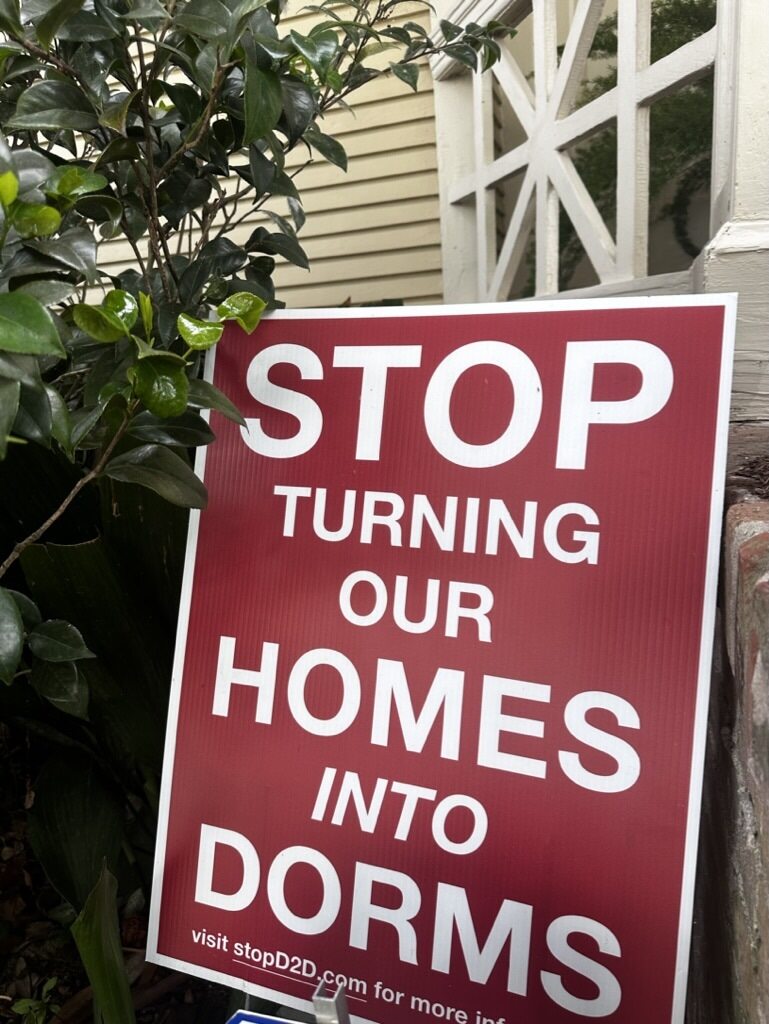
What is the line between dorms and housing? (Photo by: Dylan Forrest)
It is no secret that the homes surrounding school campuses are being turned into student housing. For the last decade, people all over the country have been trying to stop this trend from spreading and causing problems in areas like the availability of affordable housing and neighborhood control. Recently, I have taken a dive into the student housing expansion near Tulane’s campus, right here in New Orleans.
Tulane University has a significant impact on the surrounding area. With 7,350 undergrad students and only 13 residence halls, it is understandable that upper-level students would look for housing elsewhere. 46% of students live in off-campus housing that is privately owned and not affiliated with Tulane. Off-campus houses are extremely close to local residents, leading to issues with parking, noise, and excessive trash.
A non-profit organization, ‘Stop Doubles to Dormitories,’ is leading the battle against this issue. Their mission is to alleviate the constant conversion of doubles to Dormitories, or ‘D2Ds ‘, a type of student housing causing rapid changes near Tulane University. D2Ds are owned by developers in and out of state who buy properties and condense student housing together. This leads to overcrowding and a decreased quality of living for the locals who have called this area their home for years. Two of the most well-liked off-campus student housing locations close to Tulane and Loyola Universities are identified as post-Katrina gentrification hotspots. Communities that experienced notable shifts in housing and demographics following Hurricane Katrina are known as post-Katrina gentrification hotspots. Rising rents and property values in these neighborhoods attracted developers and affluent, frequently younger, inhabitants. As a result, long-term lower-class residents were forced to move since they could no longer afford to live there. Tensions between new and old residents resulted from the communities’ altered culture and character brought about by the entrance of modern facilities and new enterprises.
As a student who attends Tulane, I live in a home directly across from a “Stop D2D” sign. My roommates and I are incredibly respectful neighbors, and although this is primarily out of our control, we feel bad for hurting those who call New Orleans a permanent home. Howard and Locern Bailey, a couple who have lived in the University Area since 2002, have witnessed their neighborhood change significantly in the last couple of years. Locern stated, “The green home that hasn’t always been there.” […] That was a brick home on the corner. We knew the people who lived there. A lot of people lost their property, […] I can imagine it was probably taxes not being paid.” Locern Bailey refers to an occurrence in New Orleans that saw property values increase by at least 50% after property reassessment in 2019 and 2020.
Recently, Tulane has taken some action to address this student housing problem. Lauren Jardell, Tulane’s head of government and community relations, said, “Tulane is working hard to ease the housing shortage in the university area by building The Village, a group of new residence halls.” “When finished, which we think will be in the fall of 2025, Tulane plans for all juniors to live on campus except for students from New Orleans whose families live in the area, those studying abroad, or those who have other housing through the Goldman Center.” President Fitts added that, “The whole purpose of this is to bring students back on campus.” This is a small step towards alleviating the pressure on the nearby community. There still is a lot to be done. Tulane expected the new housing complex to be done by 2025, but students moved into River and Lake dormitories a semester late. Even with increased housing capacity, it is uncertain whether the new dorms will be sufficient to accommodate the whole junior class, leaving seniors with little choice but to seek off-campus housing. Even students who are DTD tenants themselves have the ability to participate in the STOP D2D movement actively. They can do that by being extra considerate of their neighbors and pressuring Tulane to increase on-campus living.
In conclusion, Tulane University’s growth and the need for student housing that came with it have had a big effect on the neighborhood around it, causing many problems for people who live there. One way to help ease these conflicts is for the university to keep working on projects like “The Village” that add more housing on campus. But there’s still a lot of work to be done to meet the needs of both students and long-term residents. Students, the university, and the city can all work together to make the community a better place to live for everyone.
 NOLAbeings
Multimedia artist Claire Bangser created NOLAbeings as a portrait-based story project that marries...
NOLAbeings
Multimedia artist Claire Bangser created NOLAbeings as a portrait-based story project that marries...
 Data corner: Adobe Suite (create a PDF, social media graphic, presentation, edit a photo and video
Data corner is where you go to work with analytics and top tech skills. It takes on everything from PERL and SQL to Canva and Sprout Social.
Data corner: Adobe Suite (create a PDF, social media graphic, presentation, edit a photo and video
Data corner is where you go to work with analytics and top tech skills. It takes on everything from PERL and SQL to Canva and Sprout Social.

The thrill of narrowly dodging spikes, Geometry Dash soaring through portals, and surviving high-speed segments gives players an adrenaline rush that few mobile games can replicate with such elegant simplicity and intense replayability.
[…] Impact of Tulane’s Student Housing on Local Communities […]